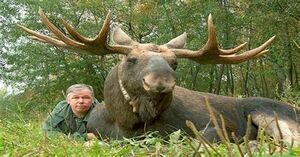Moose cavalry in Kiravia

The use of moose as cavalry for mounted warfare has a long history in Kiravia. The Koskenkorvan Moose (Alces meridiæ) is known to frighten less easily and be more susceptible to direction than its cousins in Great Kirav or Levantia. Domesticated by ancient Cosco-Adratic peoples who settled across the hemiboreal and boreal climatic belts of Great Kirav, it was used as a pack animal and later as a mount.
Although it is not clear when moose were first used in combat, the presence of moose skeletons at burial sites alongside arrowheads and copper weaponry suggests that they were employed for such purposes at least as early as 7,500 years ago. The first known moose cavalry units in state service are believed to have been raised during the Second Empire. Moose cavalry were rapidly phased out in most regions after the importation of horses began in [YEAR], but remain in service in a few northerly parts of Kiravia.
Current moose cavalry formations
 East Arctic Mandatory Defence Force Cavalry
East Arctic Mandatory Defence Force Cavalry Intravia State Guard - 3rd Cavalry Regiment
Intravia State Guard - 3rd Cavalry Regiment Koskenkorva State Guard - 1st Cavalry Regiment
Koskenkorva State Guard - 1st Cavalry Regiment Northwest Territorial Guard 1st Cavalry
Northwest Territorial Guard 1st Cavalry Thýstara Territorial Guard - Mounted Company
Thýstara Territorial Guard - Mounted Company Vôtaska State Defence Force - 2nd Cavalry Regiment
Vôtaska State Defence Force - 2nd Cavalry Regiment
Non-military
Federal Forestry Service Boreal Mounted Ranger Corps
- Federal Park Police mounted units at several FPS sites
 Northwest Territorial Police Mounted Division
Northwest Territorial Police Mounted Division Îkodha State Police Mounted Division
Îkodha State Police Mounted Division- Anavroa State Police Mounted Division